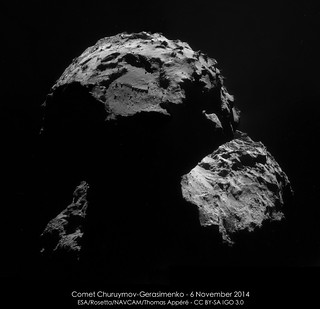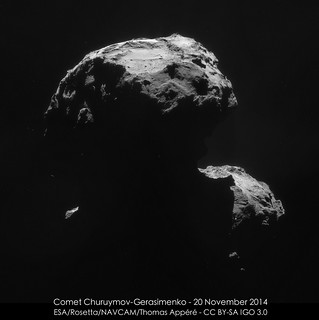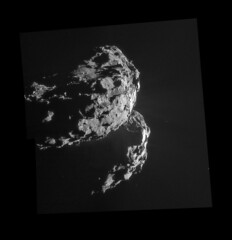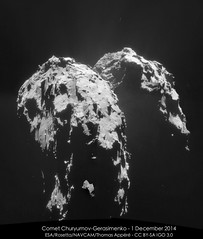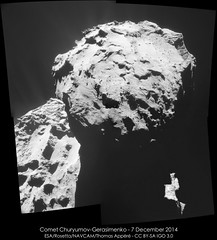I think I heard it mentioned during the press conference today, (I can't find it now), about Rosetta itself possibly landing eventually, similar to what NEAR did at the end of the main mission at Eros? Since it's not like there's anywhere else to go with the remaining delta-v left by the end of 2015, and sunlight levels and activity starting to drop after perihelion, and the low gravity makes the difference between orbiting and 'landing' trivial. The whole thing would weigh a kilo or two, right?
Obviously there's a few more pressing concerns right now, but it's something to eventually think about.
Full Version: Rosetta - Post Separation Ops at Comet 67P C-G
At some point Rosetta will run out of propellant for orbit corrections.
The mass of Rosetta at regular EOM should be 2900 kg - 660 kg - 1060 kg - 100 kg = 1080 kg.
(Start weight - propellant - oxidizer - mass of Philae, from here)
The surface gravity of the nucleus at 2 km distance from the center of mass should be
g = GM/r² = (6.672e-11 Nm²/kg² * 1e13 kg) / (2000 m)² = 1.668e-4 N/kg.
The weight of 1080 kg is F = m a = 1080 kg * 1.668e-4 N/kg = 0.18 N.
0.18 N is the force of a mass of 18.37 grams in 9.80665 m/s² gravity.
The actual weight of Rosetta would be a little less due to inertial forces by the rotation of the nucleus.
To be more precise: The centripetal force for a radius of 2000 m and a rotation period of 12.7 h = 45,720 s is m r 4 pi² / T² = 1080 kg * 2000 m * pi² / (45,720 s)² = 0.0102 N.
So we are at 0.18 N - 0.01 N = 0.17 N for Rosetta's EOM weight, corresponding to the weight of a little more than 17 grams on Earth.
That's a model estimate, and may differ, depending on the actual landing coordinates.
The mass of Rosetta at regular EOM should be 2900 kg - 660 kg - 1060 kg - 100 kg = 1080 kg.
(Start weight - propellant - oxidizer - mass of Philae, from here)
The surface gravity of the nucleus at 2 km distance from the center of mass should be
g = GM/r² = (6.672e-11 Nm²/kg² * 1e13 kg) / (2000 m)² = 1.668e-4 N/kg.
The weight of 1080 kg is F = m a = 1080 kg * 1.668e-4 N/kg = 0.18 N.
0.18 N is the force of a mass of 18.37 grams in 9.80665 m/s² gravity.
The actual weight of Rosetta would be a little less due to inertial forces by the rotation of the nucleus.
To be more precise: The centripetal force for a radius of 2000 m and a rotation period of 12.7 h = 45,720 s is m r 4 pi² / T² = 1080 kg * 2000 m * pi² / (45,720 s)² = 0.0102 N.
So we are at 0.18 N - 0.01 N = 0.17 N for Rosetta's EOM weight, corresponding to the weight of a little more than 17 grams on Earth.
That's a model estimate, and may differ, depending on the actual landing coordinates.
They have already stated they want to follow the comet during 2016, as it enters the dormant state. They would need a mission extension for that.
Since it's not like there's anywhere else to go with the remaining delta-v left by the end of 2015, and sunlight levels and activity starting to drop after perihelion
Actually, it will go somewhere, after a fashion.
67P will approach Jupiter to within 0.4 AU in Nov 2018.
Whether Rosetta will be able to do anything about it, out of power and out of fuel, is another matter.
"rejoined" (forgot password) for this epic event- hopefully it will spawn a co-op esa-nasa cometary exploration program - especially good time being alive for following an historic and species first...
ADMIN: Post moved.
ADMIN: Post moved.
Deutschlandfunk says the comet's surface remind of corals... Interesting comparison  but might lead to some misunderstanding...
but might lead to some misunderstanding...
"Coral reefs under the sea" is what Paolo Ferri supposedly said in a radio interview for HR-Info - which is where Deutschlandfunk took it from, among others. Interview isn't available online (yet?), so can't check it for certain.
Considering quite a lot of people aren't even aware corals are alive i think the extent of misunderstandings will be limited
Considering quite a lot of people aren't even aware corals are alive i think the extent of misunderstandings will be limited
I think I heard it mentioned during the press conference today, (I can't find it now), about Rosetta itself possibly landing eventually, similar to what NEAR did at the end of the main mission at Eros?
From this New Scientist story:
QUOTE
Rosetta itself could one day join Philae on comet 67P. The orbiter will run out of fuel at the end of 2016, and ESA must decide whether to put it into hibernation, or put it down on the surface.
A large flat area on the dark side of the comet was not an option for Philae, but it will be well illuminated by 2016. Rosetta could crash-land there, taking extreme close-up pictures of the comet and sniff its atmosphere on the way down. "If we are called to do something like this I would be pleased," says Accomazzo. "If you ask me personally, I wouldn't do anything else."
A large flat area on the dark side of the comet was not an option for Philae, but it will be well illuminated by 2016. Rosetta could crash-land there, taking extreme close-up pictures of the comet and sniff its atmosphere on the way down. "If we are called to do something like this I would be pleased," says Accomazzo. "If you ask me personally, I wouldn't do anything else."
Obviously it'd take a lot of precise planning, but if in the end game it was possible to drift down, and then blip the thrusters for the next-to-the-last-time to clean off the overlaying dust from the icy underside...
The long wait for an OSIRIS color image may be over:
https://agu.confex.com/agu/fm14/meetingapp.cgi#Paper/22395
The AGU abstracts are online and full of good stuff, and a very small number of them contain images, including this one.
Phil
https://agu.confex.com/agu/fm14/meetingapp.cgi#Paper/22395
The AGU abstracts are online and full of good stuff, and a very small number of them contain images, including this one.
Phil
The color mottling in that image is very interesting (other than obvious color fringes caused by rotation between frames), I wonder if that's real or an instrument artifact.
Many talks will be given to present the results from the instruments of Rosetta.
Made a new animation of navcams draped over my shapemodel. This time with the november 17 navcam quad.
My shapemodel is becoming better with each iteration. The match between features in the images and the shape of the model is surprisingly good if I may say so myself
http://mattias.malmer.nu/2014/11/navcam-november-17/
My shapemodel is becoming better with each iteration. The match between features in the images and the shape of the model is surprisingly good if I may say so myself
http://mattias.malmer.nu/2014/11/navcam-november-17/
The long wait for an OSIRIS color image may be over:
https://agu.confex.com/agu/fm14/meetingapp.cgi#Paper/22395
The AGU abstracts are online and full of good stuff, and a very small number of them contain images, including this one.
Phil
https://agu.confex.com/agu/fm14/meetingapp.cgi#Paper/22395
The AGU abstracts are online and full of good stuff, and a very small number of them contain images, including this one.
Phil
That is one very strange image indeed... the mottling is confined to a broad stripe of the image starting abruptly about 20% in from left and ending about 10% in from the right. It almost looks a little bit like it was added in post. (Scientific DRM?)
The "non mottled" areas look much nicer...
I notice that Rosetta/Philae topics get (so far) about 1500 posts and 300.000 views. Wondering if this beat Curiosity around landing time?
Newly published Navcam images of the region, 2.59 m/pixel: http://blogs.esa.int/rosetta/2014/11/24/co...ch-20-november/
ADMIN NOTE: Post moved from Philae topic to correct discussion.
ADMIN NOTE: Post moved from Philae topic to correct discussion.
the mottling is confined to a broad stripe of the image starting abruptly about 20% in from left and ending about 10% in from the right.
Very obvious if you extract the saturation channel and stretch:
Click to view attachment
Very sharp boundary between mottled area and unmottled to the right. The boundary's clearly unrelated to anything on the comet.
Yes. And the mottling seems very regular. Like a Perlin noice function...
The parts outside the area are quite nice. One could perhaps work a little on the registration of the images to get less fringing. But you can clearly see the colour of the surface change on the different terrain types. (Especially if you remove the overall red tint)
The parts outside the area are quite nice. One could perhaps work a little on the registration of the images to get less fringing. But you can clearly see the colour of the surface change on the different terrain types. (Especially if you remove the overall red tint)
Looks like noise / low resolution data. Perhaps some channels are of much lower resolution.
Thing is, looking at the rotational state in each of the rgb components, it's suggestive that the source frames cover the entire body, not a case of a colorized greyscale image at the center. Very odd.
A strongly hue and saturation stretched (hence false-color) version of the colored OSIRIS image:
Click to view attachment
My overall, somewhat subjective and qualitative impression is, that bluish spots are correlated to holes/depressions, and reddish spots to peaks/hills.
I can't say, whether this also means some correlation of hue to activity.
From the abstract of the paper I've some hope, that the OSIRIS team might have been able to quantify this presumption.
Click to view attachment
My overall, somewhat subjective and qualitative impression is, that bluish spots are correlated to holes/depressions, and reddish spots to peaks/hills.
I can't say, whether this also means some correlation of hue to activity.
From the abstract of the paper I've some hope, that the OSIRIS team might have been able to quantify this presumption.
My bet is that the image has been intentionally degraded to make sure that it is not used by anyone to do any science.
It is just way to much low frequency noise in the individual channels and there seem to be almost no correlation between surface type and color.
The images from OSIRIS we have seen so far are very very nice. there seem to be no noise pattern of any kind in those.
If one instead looks at the areas outside the noise stripe one is treated to a much higher quality.
It is just way to much low frequency noise in the individual channels and there seem to be almost no correlation between surface type and color.
The images from OSIRIS we have seen so far are very very nice. there seem to be no noise pattern of any kind in those.
If one instead looks at the areas outside the noise stripe one is treated to a much higher quality.
Is anyone interested in matching up the diagram of probable Philae landing zones with the recent Navcam images showing those parts of the comet?
The zones are just on the other side of the dark grey ridge. Our point of view is 180 degrees off from what we would need to spot Philae.
Very nice animation Mattias, as always 
Thank you. I think it is a lot of fun to do. It makes the comet more like a physical object to see it like that. And I get to learn the surface very intimately. I have over 150 surface features that I match over the images. They each have a number. Its strange to have a private toponomy like that.
I go: -ooh look there's a nice image of twelve. Now lets see if i cant find seventeen in this picture. nope. At least I can see 119. that's enough for the camera solve...
The jets are really multiplying now! Also, I think this is the first time the dark side has been visible silhouetted against the background coma - we've seen it before with Halley and Hartley-2 but not here.
http://blogs.esa.int/rosetta/2014/11/26/co...ow-of-the-coma/
Phil
http://blogs.esa.int/rosetta/2014/11/26/co...ow-of-the-coma/
Phil
Just noticed -- actually just realized what I've been seeing for some time -- that the jets are primarily pointing toward the Sun, while a comet's dust and ion tails point away from the Sun. Can Rosetta observe the process by which the trajectory changes as they become tails, or is Rosetta too close to see that effect?
... the jets are primarily pointing toward the Sun, while a comet's dust and ion tails point away from the Sun. Can Rosetta observe the process by which the trajectory changes as they become tails, or is Rosetta too close to see that effect?
Absent any atmosphere, there is no air friction to slow down the jets at they stream outward from the surface. My guess is that as the comet's surface heats up (on the sun-ward side) the jets would be streaming directly away from the surface, or towards the sun. It would only be when the comet falls deeper into the sun's gravitational well, and picks up speed, that the tail is "left behind".
I await someone more knowledgeable about comets to correct me.
My understanding was that it was the pressure of the solar wind that forms the tail(s). So heating on the sun facing side leads to jets towards the sun, which eventually are deflected by the solar wind to form the tail.
If there were no solar wind, particles in a jet pointing towards the sun would presumably get ahead of the comet rather than be left behind (at least prior to perihelion).
Edit: Phil beat me by less than a minute!
If there were no solar wind, particles in a jet pointing towards the sun would presumably get ahead of the comet rather than be left behind (at least prior to perihelion).
Edit: Phil beat me by less than a minute!
Thanks for the comments and for Phil's good link. The question remains, however, of what details Rosetta will be able to provide about the process changing jets emerging on the sunward side of the nucleus into tails streaming away from the Sun.
Steve M
Steve M
Small grains should be more susceptible to solar wind and radiation.
The GIADA instrument should be well-suited to investigate this question in very detail:
The GIADA instrument should be well-suited to investigate this question in very detail:
QUOTE
GIADA (Grain Impact Analyser and Dust Accumulator) will measure the number, mass, momentum and velocity distribution of dust grains in the near-comet environment. Giada will analyse both grains that travel directly from the nucleus to the spacecraft and those that arrive from other directions having had their ejection momentum altered by solar radiation pressure.
GIADA should provide interesting velocity data. Look forward to more GIADA insights into dust particle trajectories since since this early detection of a few dust particles.
Beautiful. Thanks for sharing that. It's amazing to pan around that view. What a place!
Lovely mosaic eliBonora! The one on the ESA blog has a blurry seam, where the foreground and background limbs meet, that had me scratching my head until I saw yours 
Here are a couple attempts at anaglyphs from the Dec 1st and 2nd NAVCAM images, made from the slices where the bottom two (foreground) images overlap. Some artistic liberties have been taken to account for areas which were shaded in one image and lit in the other.
Here are a couple attempts at anaglyphs from the Dec 1st and 2nd NAVCAM images, made from the slices where the bottom two (foreground) images overlap. Some artistic liberties have been taken to account for areas which were shaded in one image and lit in the other.
Lovely mosaic eliBonora! The one on the ESA blog has a blurry seam, where the foreground and background limbs meet, that had me scratching my head until I saw yours 
Thank you Dan. Nice anaglyphs.
I think the difference is that we combine these comets by hand and we don't use the software's blending option.
The latest Navcam blog shows new - or apparently new - features in the neck. Here's a comparison between October and December images (December on the right). I would suggest a close examination of images would probably show more things like this.
Phil
Click to view attachment
Phil
Click to view attachment
Sure enough, here's a comparison between 24 September and 9 December with the new feature on 9 December noted. Differences in lighting and resolution are small enough that I think this is a real change.
Phil
(PS... must work on book... must work on book... aaaargh!)
Click to view attachment
Phil
(PS... must work on book... must work on book... aaaargh!)
Click to view attachment
I would guess the pit is a low profile feature that produces shadows only when sunlight is at a very low angle. Otherwise, the lack of albedo differences in the smooth material renders it invisible otherwise.
Of course, the very recent formation of a collapse pit would be pretty cool....
Of course, the very recent formation of a collapse pit would be pretty cool....
I don't think the lighting is sufficiently different for the pit to not show up in the earlier image. What you describe is always a possibility in this type of comparison, but I don't think it applies here.
Phil
Phil
If it's all real, and it sure looks like it is, this will set some significant constraints on the life expectancy of comets in the inner Solar System. Could be a huge mission finding.
Well spotted, Phil!!!
Well spotted, Phil!!!
I spotted the second example, but it was the Rosetta blog:
http://blogs.esa.int/rosetta/2014/12/11/co...tch-9-december/
which drew attention to the first one. I just illustrated that first one.
Phil
http://blogs.esa.int/rosetta/2014/12/11/co...tch-9-december/
which drew attention to the first one. I just illustrated that first one.
Phil
If the pits did form very recently, then the smoothing process must have been recent as well.
This is a "lo-fi" version of our main content. To view the full version with more information, formatting and images, please click here.
